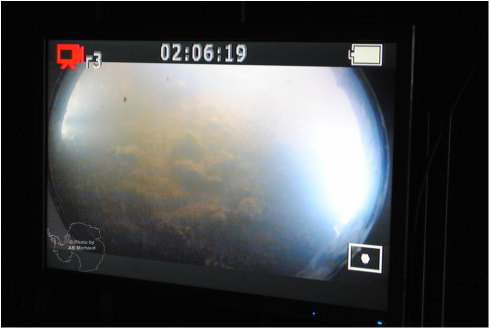Postdoctoral Research at Bigelow Laboratory for Ocean Sciences

Permafrost contains massive amounts of carbon. The fate of this carbon is dependent on the activity of iron-reducing bacteria or methanogens that breakdown the carbon to either carbon dioxide or methane, respectively. The activity of iron-reducing microorganisms is dependent on a supply of thermodynamically favorable Fe(III)-oxides to be used as a terminal electron acceptor. One way these Fe-reducing bacteria may be supplied favorable electron acceptors is through the production of biological iron oxides by Fe-oxidizing bacteria. Fe-oxidizing bacteria produce conspicuous reddish-orange mats, as seen in the photo to the left, and are abundant in the Alaskan Arctic (so are mosquitoes...). I want to know if these biological Fe(III)-oxides provide a competitive advantage to Fe-reducing bacteria for carbon mineralization over methanogens.
I will use field-site monitoring, microcosm experiments, and genomics/metagenomics to determine the impact of biological Fe(III)-oxides on carbon mineralization in the Alaskan tundra.
Results from this research have been published in FEMS Microbiology Ecology.
Postdoc Research at Aarhus University
Arctic fjord sediment biogeochemical cycles

In the Arctic, much of the subglacial discharge from glaciated catchments passes through fjords before release to the continental shelf regions. The supply of Fe and Mn from a glacier, through the fjord and to the marine shelf environment is dependent on the microbial rates and reactions that catalyze metal transformations in the fjord sediment. Fjords are more than a link between glaciers and the open ocean; they function as a biogochemically active interface between terrestrial subglacial processes and the marine environment. Thus, Arctic fjords are significant in the processing of important elements, such as Fe and Mn.
Microorganisms are important drivers of biogeochemical cycles (i.e., Fe, Mn, S) in fjord sediments, but current and future large-scale glacial controls on the rates of microbial biogeochemical cycling are uncertain. Given the paucity of data linking microbial rates of Fe, Mn, and S cycles with the active microbial populations and the significance of these biogeochemical cycles within changing Arctic fjords, my postdoctoral research will contribute to answering the question: How does current glacial activity and future glacial retreat impact the rate and composition of microbial communities contributing to metal export from fjord sediments?
The Western Svalbard fjords represent a natural laboratory to address open questions concerning the role of microbial biogeochemical cycling in permanently cold marine sediments. These fjords have different sedimentation regimes, glacial activities, and bedrock types which allows for the impact of microbial metal cycling on the export of Fe and Mn to the shelf environment to be investigated.
Results from this work has been published in the journals: Nature Communications, Limnology and Oceanography, Geochimica et Cosmochimica Acta, Geomicrobiology Journal, Applied and Environmental Microbiology, Journal of Marine Systems.
PhD Research at Montana State University
Whillans Ice Stream Subglacial Access Research Drilling (WISSARD): Geomicrobiology of Subglacial Lake Whillans Sediments

Biological ice nucleation of hailstones

Hail has been a long-time nuisance to human agriculture and economy. The negative effects of hail have stimulated much research into the formation and prevention of hailstorms. I became interested in hailstones after a large storm pummeled Bozeman, MT in June 2010. My questions surrounding what nucleates hailstone embryos, the initial growth phase of a hailstone, was stimulated by recent studies documenting the role of biological ice nucleation in rain and snow. Hail is built in stages. The first stage is the embryo. The embryo is usually a frozen drop of water or agglomeration of ice crystals. These embryos form in a low altitude, warm cloud, ahead of the main anvil-looking thunderstorm cloud that is symbolic of hail and strong thunderstorms. These embryos freeze and then swept into the warm updraft, which begins the growth phase. The embryo now collects supercooled water droplets as it rises in the cloud. It falls and rises again gaining layers and mass. Once the mass of the hailstone overcomes the strength of the warm air updraft, it falls to the ground. These layers are a record or profile of the hailstones life history. We can peel away the layers to access the embryo and ask pointed questions regarding what was present when the embryo was nucleated. We found that biological ice nuclei were present in the embryos and stable isotopes of water corroborated our freezing experiments. These results support the findings from many physical studies of hailstones in the 1970’s and 1980’s.
This work has been published in the Journal of Geophysical Research: Atmospheres.
Distribution of Cyanobacteria in the McMurdo Dry Valleys Region, Antarctica

The McMurdo Dry Valleys region is the most extreme polar desert on Earth. The ability of microorganisms to live in this harsh habitat is their ability to cope with dessication, high solar irradiance, no solar irradiance, and extreme cold. Cyanobacteria are one of the most successful organisms in this polar desert. Their growth during the short austral summers provides reduced carbon compounds to heterotrophic organisms. Cyanobacteria are the “Giant Sequoias” of the McMurdo Dry Valleys, if you will. I was interested in their distribution and taxonomy throughout Taylor Valley. Using two different molecular markers, I showed that there is a net transport of microorganisms down-valley, towards the sea. Also, as you move towards the sea, the diversity of cyanobacteria present increases. We hypothesized this was due to the high-energy fohn wonds that are characteristic of the Dry Valleys region. These strong winds redistribute sediment and also microorganisms, influencing their distribution and diversity.
This work has been published in FEMS Microbiology Ecology.
